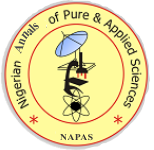Manganese (II) and Cobalt (II) Acetylacetonates as Antimicrobial Agents
DOI:
Keywords:
Transition Metal complex, Antimicrobial Activity, Pathogens, ligand, Minimum Inhibition ConcentrationAbstract
Mn(II) and Co(II) complexes were prepared by reaction of the metal chlorides with acetylacetone in ammonical aqueous medium. The metal complexes were prepared in order to investigate their antimicrobial activity on some selected pathogens. The characterisation of the complexes was on the basis of various spectroscopic techniques like infrared and ultraviolet studies. The compounds were subjected to antimicrobial activity screening using serial broth dilution method. Minimum Inhibitory Concentration (MIC) and Minimum Bactericidal/Fungicidal Concentration (MBC/MFC) were determined. Mn(II) complex has shown significantly both antibacterial and antifungal activity with a MIC of 1.25 μg/mL while Co(II) complex was noticeable for antifungal activity at the same concentration. Whereas Mn(II) acetylacetonate is a more potent bactericide while Co(II) acetylacetonate is a more potent fungicide, both with MBC/MFC value of 2.5 μg/mL. Antimicrobial agent of the ligand has enhanced on complexation with Mn(II) and Co(II) ions. Though, the potency of the prepared antibiotics on the tested microbes is less compared to the standard drugs (Ciprofloxacin and Fulcin).



 Contact Us
Contact Us Editorial Team
Editorial Team Join As A Reviewer
Join As A Reviewer  Request For Print Copy
Request For Print Copy


 Cprint Publishers
Cprint Publishers